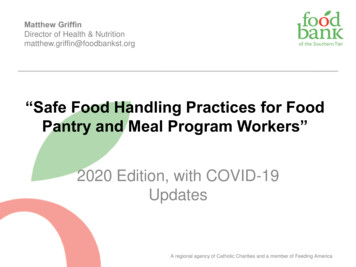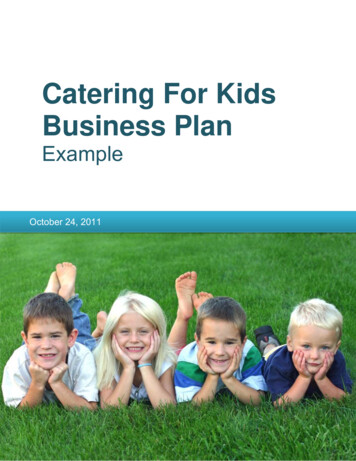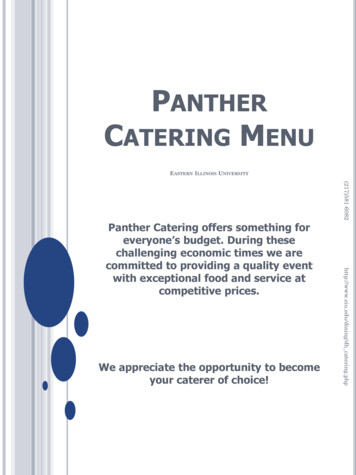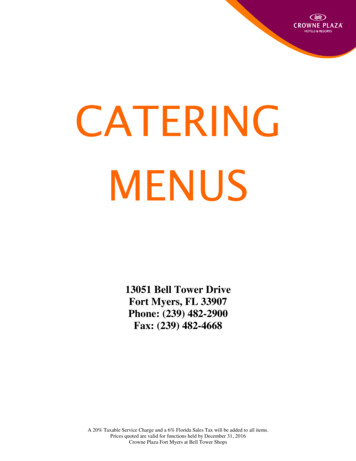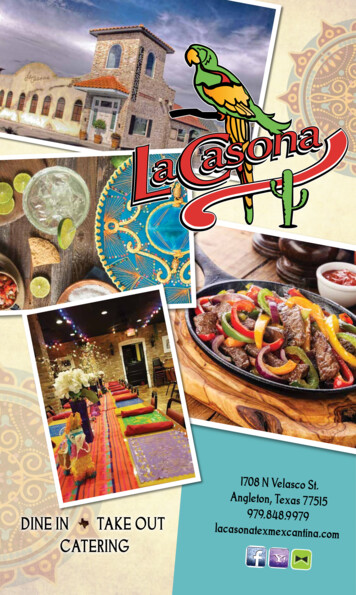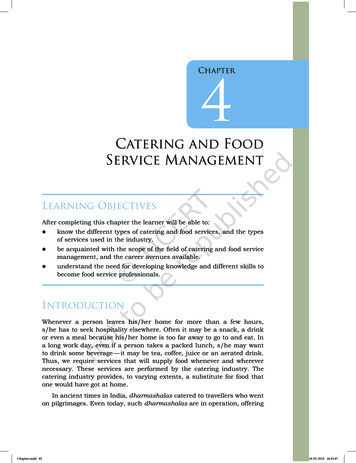
Transcription
4ChapterCatering and FoodService ManagementLearning ObjectivesAfter completing this chapter the learner will be able to:zzknow the different types of catering and food services, and the typesof services used in the industry.zzbe acquainted with the scope of the field of catering and food servicemanagement, and the career avenues available.zzunderstand the need for developing knowledge and different skills tobecome food service professionals.IntroductionWhenever a person leaves his/her home for more than a few hours,s/he has to seek hospitality elsewhere. Often it may be a snack, a drinkor even a meal because his/her home is too far away to go to and eat. Ina long work day, even if a person takes a packed lunch, s/he may wantto drink some beverage — it may be tea, coffee, juice or an aerated drink.Thus, we require services that will supply food whenever and wherevernecessary. These services are performed by the catering industry. Thecatering industry provides, to varying extents, a substitute for food thatone would have got at home.In ancient times in India, dharmashalas catered to travellers who wenton pilgrimages. Even today, such dharmashalas are in operation, offeringChapters.indd 858516-02-2018 16:45:47
Human Ecology and Family Sciences – Part 1an economical place to stay and have meals. Besides this, at religiousplaces, it is traditional to give prasad or langar to the devotees. Similarly,during the month of Ramzan, food is provided to all people when theybreak their fast. All of these foods are prepared in very large amounts, bypersons who have the expertise to do so.With changes in the socio-economic scenario, food service and cateringhas evolved into an industry that is expanding, as there is much greaterdemand for food outside home which is tasty, hygienic, healthy andaesthetically served. In some situations, there is a demand for food withlonger shelf life. Scientific and technological advancement has helpedthose involved in mass production of food to streamline their activities,be more effective, improve the safety and quality and yet make it lesstiring. Use of computers has also contributed tremendously- not just formaintenance of records, accounting systems, but also for on-line orderingof food, information about equipment manufactured in different parts ofthe world and recipes for various preparations.SignificanceToday with increasing migration, urbanisation, globalisation, internationaltravel, tourism, exposure to various cuisines and advertisements, as wellas increasing interest of local people to try out new foods, there is demandfor variety of cuisines and typical ethnic foods. Fig. 4.1 shows the factorsinfluencing development of food services.Tradition elopmentof tSocial and economicchanges86Chapters.indd 86Fig. 4.1: Factors Influencing Development of Food Services16-02-2018 16:45:47
Food needs to be provided to people of all ages, in all walks of life, atany and all times in a 24-hour period. One thing is common to all – theneed for food to be cooked and served well. Besides, providing food atthe workplace, institutions providing care for different target groups, suchas hospitals, old age homes, orphanages, hostels, have developed. Otherinstitutions where food is routinely provided are school/college/office,prisons, feeding programmes undertaken by the Government or voluntarysector to improve the health and nutrition of specific groups.Unit II - Nutrition, Food ScienceAnd TechnologyKnowledge of a variety of cultures and their ways of cooking is important.Thus people involved in this business need to have broad culinaryexperience. Media, particularly television, has stimulated interest incooking and the different food patterns of various cultures. Have you seenmost TV channels deal with cookery and cuisines? In India alone, we havea very wide variety of typical cuisines from Kashmir in the North to TamilNadu and Kerala in the South, to the North Eastern states, Orissa andWest Bengal in the East to Gujarat and Maharashtra in the West. Thishas made “Cuisinology” an area of interest and provided new professionalavenues. Similarly, across the world, there are numerous cuisines e.g.British, Welsh, Irish, Scottish, French, Italian, Spanish, German, Austrian,Russian, Eastern European, Swiss, Scandinavian, Mediterranean andMiddle Eastern, American, Mexican, Caribbean, African. In Asia andS.Asia, besides Indian, we have Pakistani, Bangladeshi, Thai, Chinese,Korean, Japanese, Indonesian, among others. In each of these cuisines,the ingredients used and the methods of preparation vary considerably.Services that cater/provide food service are also knownas Catering Services.Catering can also be regarded as a service that provides a pleasantchange from home cooked food. People like to enjoy a meals/snacks/beverages that have been prepared and served in different and pleasantsurroundings. More families are now eating out at weekends or go out toeat sometimes in the evening for pleasure. Also, many families increasinglytravel away from home on holidays. They need to eat while traveling andthroughout the holiday period in restaurants/hotels etc, making nationaland international tourism and catering a ‘growing’ industry.There are individuals or groups who prepare food and send them topersons at their places of work or to their homes. This is known as home –based food service. Such entrepreneurial catering activities are many, forexample take home meals/ delivery of home made meals. Many of theseChapters.indd 878716-02-2018 16:45:47
Human Ecology and Family Sciences – Part 1enterprises are undertaken by women who use their interests and skills atcooking. The demand for food to be catered is brought about by the largenumber of families where both husband and wife are working, and in someplaces where people live alone / have limited facilities for cooking or areunable to cook for themselves. There are also mobile units that serve food.Provision of food/snacks, beverages is needed in community activitiessuch as fairs, exhibitions, flower/fruit/vegetable shows where visitorswould like to avail of some refreshments. Similarly, refreshments may beserved at a rally, lunches may be served at some meeting etc. All of thesereflect the scope of opportunities to be found in the catering industry andthe potential for different careers in this field of food service management.Before we discuss the various careers, let us acquaint ourselves withimportant concepts and aspects that are relevant to this industry.Basic ConceptsFood service industry is large and encompasses those places, institutionsand companies that are responsible for any food or beverage preparationoutside the home. These vary from expensive hotels and restaurants toless expensive outlets such as fast food outlets, food services in canteens/cafeterias in schools, colleges, universities, industries, offices etc.Food service management is the art of providing food and beveragesaesthetically and scientifically to a large number of people, in a satisfactoryand cost effective way. It requires a professional approach along withspecial skills, knowledge and vigilance at each and every stage in foodservice operation. Food service industry may also be referred to as ‘catering’industry.Food service is the practice or business of making, transporting andserving prepared foods. The purpose of food service is to supply palatablefood prepared under acceptable standards of sanitation, aestheticallyserved at specified cost.Food service manager is the one who assumes responsibility for themanagement and administration of a food service unit /department /organisation.Menu compiling is one of the most important jobs in catering. Allactivities in the food service unit are influenced by the menu. The menudetermines the ingredients required, the type and number of equipment,the expertise of the personnel and the number to be employed.88Chapters.indd 8816-02-2018 16:45:47
Let us acquaint ourselves with the types of food service establishments.Types of Catering ServicesCatering ServicesWelfare orNon-commercialHotels andCommercial CateringFig. 4.2: Types of Catering ServicesUnit II - Nutrition, Food ScienceAnd TechnologyCatering services can be broadly categorised as shown in Figure 4.2 , basedon their social and economic significance. This categorisation is based onwhether the aim of the catering is primarily profit making or otherwise.Welfare / Non-Commercial Services: The major purpose of these servicesis philanthropy and social welfare. Persons / organisations who undertakethese services, aim to ensure that people are well and properly fed, and ifany profit is made through their business, it is of secondary importance.Examples of such catering services are feeding people at workplaces,the armed forces, in schools, in supplementary feeding programmesimplemented by the government or for sick people who are in hospitals.Industrial catering is one form of welfare catering. Many industries providefood to their employees as part of their welfare activities. It is believed thatwork output is related to the welfare of the employees. Well-fed workersproduce more and better work. Workers receive free food or food at a pricemuch lower than its actual cost (subsidised), with the rest of the cost beingborne by the company. In industrial, institutional and welfare outlets theobjective is mainly to provide a necessary service. Caterers / managers ofthese services may be given limited budgets within which they are requiredto successfully manage the operations. In such situations, the caterer maynot be in competition with other caterers for business since the functions‘belong’ to the employing organisation. Also, in such establishments,the service is not available to the public, but only to the members of theinstitution /organisation for which the service is operated.Commercial Services: Such services and establishments are open to thepublic and sell food and beverages primarily to make a profit. However,these services are valuable because they provide for the needs of theirChapters.indd 898907-05-2018 12:11:20
Human Ecology and Family Sciences – Part 1consumers as well as are source of employment. Also, these serviceshave tremendous economic significance to the country. Hotels andcatering services support the tourist, travel and holiday industries. It isa major earner of foreign exchange since this industry brings money intothe country in exchange for its services. Through the tourism industry,hoteliers and caterers indirectly contribute to advancing understandingbetween different countries.Quantity Food Preparation by aFood Production in a School CanteenWomen’s groupExamples of establishments that undertake food service and sales aregiven in Table 4.1.Table 4.1: Types of Food Service EstablishmentsWelfare CateringCommercial CateringMid-day meals in schoolsSmall to large hotels, restaurants, dhabas,cafesSchool food servicesExpensive luxury restaurants, Spas,Speciality restaurantsIndustrial canteens( when employersprovide free or subsidised food toemployees)Guest houses, Holiday campsInstitutions – school and collegehostels, working women’s hostelsFast food joints/ Take away(quick servicerestaurants)90Chapters.indd 9007-05-2018 12:11:20
Snack barsOld age homes, nursing homesCoffee shops, speciality food services e.g.ice cream parlours, pizzaOrphanagesFood services in cinema halls, theatres,mallsPrisonsWine BarsDharmashalasTravel services on sea, land, air (Transportcatering) e.g. flight kitchens, buffet carsin trainsLangar, Prasad including meals offeredto devotees at templesCatering for seminars, workshops,conferences, parties and weddingsFeeding programs undertaken byreligious orders e.g., RamkrishnaMission, ISKCONCatering for industries and institutionson contract basis ( in-house food service)CrechesChain catering organisationsSupplementary feeding programmes ofgovernment/municipality e.g., Middaymeal programme, ICDS’ supplementaryfeedingClubs/gymkhanasUnit II - Nutrition, Food ScienceAnd TechnologySpecial needs e.g. hospitals,Mobile CateringActivity 1In your area/ region find out the various catering services availableand identify whether they are commercial or welfare.91Chapters.indd 9116-02-2018 16:45:48
Human Ecology and Family Sciences – Part 1Styles and standards of functions in catering by the commercial sectorvary widely:zzAt internationally famous 7 / 5-star establishments are elegant,luxurious, usually a large variety of cuisines are available, andthe banquet manager has at disposal all the resources of skill andequipment needed. It requires highly skilled professionals and iscostly to provide and maintain. Prices at such establishments arealways extremely high.zzLess expensive establishments such as 3 / 4 star hotels, restaurants,etc. have a pleasant and cheerful ambience, the food and service isof a high standard where costs and prices are less than at the verytop level.zzSmall restaurants using minimum number of equipment and food isrelatively cheaper. Menus may not be varied much.Having acquainted ourselves with types of food service establishments,it is also important to have some knowledge about types of food servicesystems and delivery of foods.Types of Food Service SystemsThere are basically 4 types of food service systems—conventional,commissary, ready prepared and assembly/serve.92Chapters.indd 921.Conventional food service system: Food is prepared in a kitchenon the premises where the food is to be served. Following foodpreparation/ production, food is held hot or cold and served as soonas possible. The food may be distributed for service directly to anadjacent service area e.g., in cafeterias, restaurants, dining hallsof hostels. Alternatively it may be carried on trays e.g., served topatients in hospitals. This system is more adaptable to individualpreference
Thus people involved in this business need to have broad culinary experience. Media, particularly television, has stimulated interest in cooking and the different food

